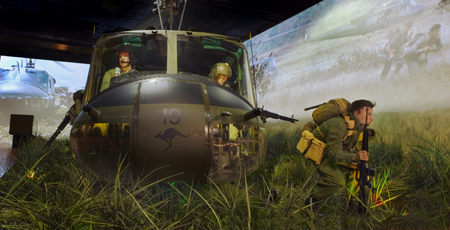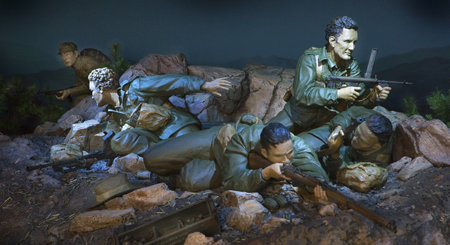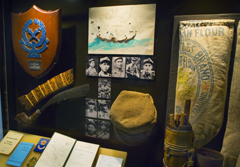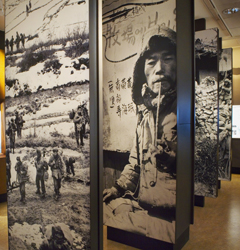review by John Murphy


This uniform represents the 'full kit' of a modern soldier and contrasts with the uniform of Private Giles in the First World War galleries.

This diorama depicts a moment during the Battle of Kapyong (Korean War) in April 1951. The Australian War Memorial has displayed dioramas since the 1920s, but the use of digital technology in this diorama reinvigorates the tradition by adding subtle light effects and an oral history recording of Corporal Ray Parry relating his experience of the battle.
While I was there, it captured the attention of an unruly group of school children, but in a way that dramatised the split that the Memorial's historian Michael McKernan observed some time ago about the institution. It is both a museum with work to do in interpreting the past, and a memorial with work to do in enabling grieving and remembrance. The 'Heliborne assault' installation is especially loud, with flashing lights and helicopter rotors thudding, and the children, quite understandably, got caught up in the excitement. They screamed wildly, shouted at each other over the noise, and a couple of young boys mimicked firing imaginary machine guns. At the end, they broke into loud applause and more shouting. An usher tried to hush the children.
In one sense, it might be the sort of audience engagement a museum would die for and it is, after all, invited by the nature of the installation. But when I later spoke to the usher, she commented that they worried about the loss of 'respect and reverence' involved in these reactions; it seems it happens too often, and distresses some veterans who have witnessed it. The episode nicely captures the dilemma. All museums are sites of memory, but the War Memorial straddles a double function as both a museum and a sacred space. This kind of installation, and the excitement it naturally creates, sits oddly with the overtly commemorative aspects of the Memorial, the meanings it conveys of reverence and grief, and the place in that reverent tradition that some Vietnam veterans understandably desire.
As the Memorial's own brochure asserts, 'the Commemorative Area is the heart of the Memorial'. Even the names of these areas signal their quasi-religious role. There is the 'Pool of Reflection' and the 'Eternal Flame', the 'Roll of Honour' in the 'Cloisters', and the 'Unknown Australian Soldier' entombed in the 'Hall of Memory'. The latter is itself a kind of secular chapel complete with stained glass windows. These are, in a sense, earlier installations that used architecture to do the work of creating a sacred place. It is a dimension of sanctification, wreath-laying and remembrance that historian Ken Inglis noted was part of the Great War memorials throughout Australia's country towns and cities. They were sacred places and sites of grieving, and the Australian War Memorial is the sacred place par excellence.
The Memorial carries a heavy burden of national mythology, and this also makes it an intensely political place. When he first opened it on 11 November 1941, Prime Minister John Curtin described it as a 'sanctuary of Australian tradition'. Sanctuary is an interesting word, resonant of Bean's original idea of a reliquary. And Curtin noted that it was 'extraordinarily appropriate' that the Memorial was in a direct line of sight to (old) Parliament House, now with the new parliament behind it. The buildings form an axis symbolically ordering political space in the national capital, conveying how the Memorial's imagining of military memory is at the centre not only of conservative, but also some popular imaginings of the nation. Where Washington is laid out as a symbolic triangle of the Congress, the White House and the Washington Monument, Canberra is laid out with the Parliament and the War Memorial facing each other (and, in fact, with the High Court and the cultural monuments of the National Library and the National Gallery then forming the arms of a cross). So, as well as being a reliquary that evokes the everyday experience of ordinary soldiers, the Memorial carries this role of secular sanctity. Hence the political importance for some Vietnam veterans of being finally placed at the centre of the Memorial.
But this political significance also helps explain why the Memorial has so often handled the politics of war with such awkwardness. Politics in its most formal sense is largely absent from its galleries. With the post-1945 gallery, an uninformed viewer would learn very little about who the governments were that committed the troops, and little of what their rationales were. Similarly, one learns from the gallery devoted to the Great War, which the memorial was first built to commemorate, little about the conscription dispute that so deeply divided Australians and split the Labor Party. Even apart from the formal politics of government policies, war also has a politics in its prosecution, in the mobilisation of popular support and the containment of opposition, in the ways that armed forces have to attend to 'hearts and minds', and in the ways that senior military commanders are political actors fighting bureaucratic battles, implementing policies and leading forces. These sorts of issues may be deemed inappropriate in a memorial. While a war museum might be able to explore them, a memorial has less room for interpretation as it goes about its sacred and commemorative work. So in this realm, the War Memorial's motto could be 'theirs not to reason why'.
But, of course, the War Memorial is aware that the wars since 1945 have been more vexing and more divisive than the two world wars. Perhaps from Korea on, certainly from Vietnam on, there is a domestic and political context that has to be accommodated somehow and can hardly be avoided. In 2007, Steve Gower, the director of the Memorial, himself a Vietnam veteran, described the purpose of the new gallery as to 'tell the stories of our veterans in an engaging and uplifting manner'.[1] But it would be implausible to focus only on the 'uplifting', and to ignore altogether those who opposed the Vietnam commitment and especially conscription for it, and perhaps also those who have opposed the two Gulf wars. Flying up to Canberra for this review, I found myself questioning how much political engagement with the opponents of these wars could one reasonably expect from a place that exists as a shrine to military memory. Is it even fair to expect that the political divisions of Vietnam, the reasons behind the war and the reasons behind opposition to it, could be fairly and evenly represented?

Australian War Memorial
In the cross-fire of these conflicts, it is simpler for the War Memorial to fall back on its role as memorial rather than museum. But then how to deal with the unavoidable politics of the Vietnam War? The panels of text in the new gallery that deal with Vietnam are frequently circumspect, but give a brief and conservative account of what was happening in the lead-up to the war. For example, regarding the 1954 partition after the collapse of French rule, one panel states that 'elections were stalled, and North Vietnamese forces and communist guerillas conducted an insurgency of terror and political indoctrination against the south. During 1961–2, the President of South Vietnam repeatedly asked the United States and its allies for security assistance and aid'. That is not inaccurate, but it is highly interpretative. It leaves out, for example, that the elections were stalled because Ho Chi Minh's Communist forces would have won them, and that President Diem's heavy-handed repression in the south fed the insurgency there.
This glossing over the reasons why the conflict developed means that the visitor is provided with no insight into why the intervention by the United States and its allies (primarily Australia) was resisted so long, and so successfully. Once troops were committed, the Memorial's view appears to be that the time for reasoning why is over, and hence the opposition to conscription and the war starts to necessarily appear as unreasonable. Yet the opposition has to be included, and is, in a series of panels that include a short film primarily about the anti-conscription campaigns, student protests and then the Moratorium. But because the focus of the Memorial is on conveying the everyday experience of ordinary men and women in the forces, and is certainly not on debating the merits of a war, the anti-war movement is principally represented as meting out unfair treatment to returning soldiers.
The tone here is one of bitterness, presumably reflecting the extensive consultation with veterans' groups who were evidently treated as the main 'stakeholders' in the development of the new gallery. As one panel reads: 'Belated recognition by the Australian public that protests against Vietnam veterans were misdirected has helped servicemen and women serving overseas today to avoid similar treatment'. This skewed representation of the anti-war movement as disloyal to the Anzac spirit is quite powerful in positioning opposition to the war as illegitimate, even churlish. It tells the reader nothing about why opposition grew into such a substantial social movement, and why participants ranged from far left student groups and the Australian Labor Party, to the main churches, pacifists and opponents of conscription. It explains nothing of the extensive debate for and against intervention that ran for a decade. And it educates neither visitors nor veterans about trying to understand why the Vietnam War was so political, so controversial.
The Memorial shies away from formal politics, but this representation of the anti-war movement strikes me as highly political in itself. It positions a mass movement against the war as disrespect to the 'Anzac spirit' of Vietnam veterans, and in the process works to incorporate the veterans of primarily the Vietnam War (and in their train those of the other post-1945 wars) into the hushed and reverential tones of the Memorial. The tension McKernan noted between a museum and a memorial is highly relevant here. The sound installations using the Iroquois helicopter might excite children to irreverent frenzy, but the real purpose of the post-1945 gallery is to induct Vietnam veterans into the 'Hall of Memory'. Following the belated 'Welcome home' parade in Sydney in 1987, and then the erection of the National Vietnam Forces Memorial in 1992 (on the broad Anzac Parade running from the Memorial towards the Parliament) the new gallery is a final enactment of homecoming, with the Vietnam veterans brought into a space where silence reigns. That may be where some of them want to be, and who are we to deny them this wish, but it suggests that a rounded account of the Vietnam War will have to take place somewhere else.
John Murphy is a historian and associate dean (research) in the Faculty of Arts at Melbourne University.
| Institution: | Australian War Memorial |
| Exhibition team: | Australian War Memorial staff |
| Design: | Cunningham Martyn Design and subcontractors |
| Gallery space: | about 1700 square metres |
